Family : Ailuridae

Text © Dr Davide Guadagnini

English translation by Mario Beltramini
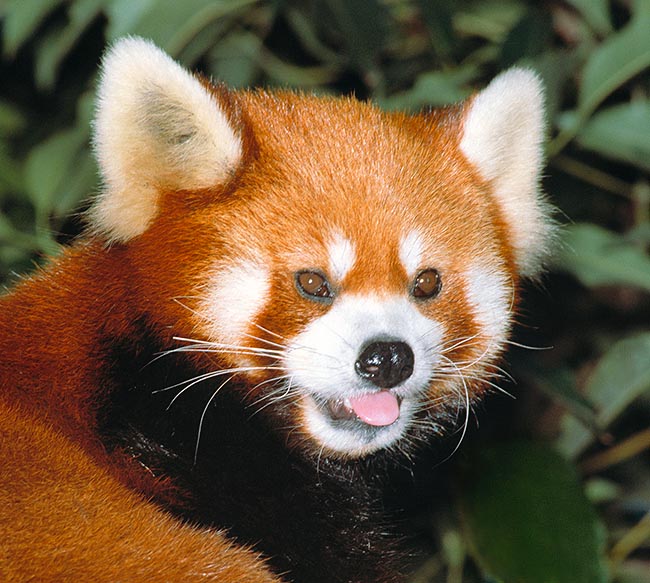
Living fossil, the Lesser Panda or Red Panda (Ailurus fulgens) has a family all for itself © Giuseppe Mazza
The pleasant Lesser panda or Red panda (Ailurus fulgens F. Cuvier, 1825) is a mammal of a nice look and with a peculiar alimentary physiology.
It belongs to the order of the Carnivores (Carnivora), is the only member of the family of the Ailurids (Ailuridae) and of the genus Ailurus to which it belongs as only species: Ailurus fulgens.
Two subspecies are present: Ailurus fulgens fulgens, Ailurus fulgens styani. The subspecies styani is bigger and has a darker colour in respect to the nominal one.
The name of the genus “ailurus” comes from the old Greek “αἴλουρος” = “ailouros” which means “domestic cat” due to some attitudes and behaviours of this species that at times can recall the domestic cat. The name of the species “fulgens” comes from the Latin and means bright, brilliant, splendid and refers to the brightness and the colouration of its thick fur. The scientific name, in this case, is therefore a direct description of the animal. Its Chinese name is quite beautiful meaning “fire fox”.
Zoogeography
Asian species; its distribution in the wild is not much known. This animal lives along the southern margin of Himalaya, in a territory which includes Nepal, India, Bhutan, Sikkim, the northern regions of Assam and of Burma, the western Chinese provinces of the Yunnan, and of Szechwan. The subspecies “styani” is located in central-southern China and in north-eastern Burma.
Ecology-Habitat
Its habitat consists in forest, mainly of bamboos, located between the 1500 and the 4800 metres of altitude where the temperature is not particularly rigid and rather constant. The lesser pandas go wandering in the bamboo forests dominated by shrubs and herbaceous essences. With regard to the temperate-humid climate of its habitat, the lesser panda shows a certain sensitiveness to heat (its well-being status is greatest when the temperatures do not exceed the 25 °C). For this reason, it shelters from the sun’s rays seeking refuge in the shade of the branches, into the cavities of the trees or in the cracks of the rocks. It sleeps not disdaining, on the contrary, the sunny areas when it is cold and when it has to save energy.
Morpho-physiology
It is a high mountain mammal with very distinctive physical characteristics: big head, short neck, long banded tail, round face, white muzzle, facial mask, pointed ears and strong legs. It weighs 3-6,5 kg (usually, the males are little heavier than the females) which allows it to climb even in the highest and thinnest parts of the trees. Its body is 50-65 cm long and is 20-25 cm tall at the withers.
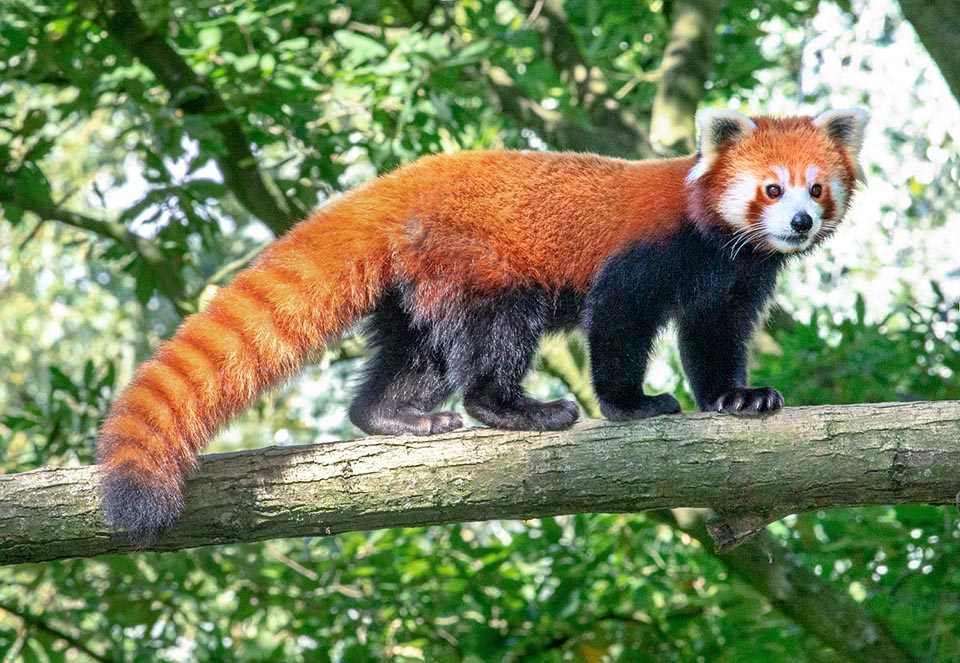
High-mountain mammal, it is present along the Himalayan southern edge. Withers at 20-25 cm, it reaches 50-65 cm, almost as much of a tail © Giuseppe Mazza
The Lesser panda has a very useful and nice fur: thick hair, silky, rather long, glossy and with a peculiar colouration. Its pointed muzzle, short and little prominent due to the thick layer of hair, expands in the frontal region. The eyes are moderately large, the ears are straight and pointed. The legs are short, robust and end in big claws, massive, sharp, curved and partially retractile. The wrist has a particularly developed bone (sesamoid) which has more or less the same function as the thumb (called, therefore, “false thumb) of the primates as it permits to catch and keep the grip on the bamboo stalks for eating them. The tail is long (28-60 cm) almost as long as the rest of the body and is covered by very abundant long hair which gives it a cylindrical shape of great size.
This big tail is utilized as pillow-blanket for preventing the dispersion of the body heat and is an important natural means of balancing during the deambulation or when standing up on the hind feet.
The well contrasted colour off the mantle renders this animal one of the most admired guests of the zoological gardens; this also because of the easy to guess softness and of the structure of the fur (like a plush) combined with unsteady gait and at times clumsy which confer it a tender aspect. The base colour is reddish or red-rusty in the upper part of the body, bright and with a rusty brightness on the back (with yellow-golden honey small flakes).
The lower part, the legs, the throat and the chest have a nice hair always glossy, but black. The colouration of such livery is a case of little diffused selection and known under the term of “inverted colouration” that is found also in the European badger (Meles meles) and in the Golden hamster (Mesocricetus auratus) with wild colouration. Covered of white hair are, on the contrary, the muzzle up to the eyes, the inner part of the ears, some roundish spots placed over the eyes and two stripes of the cheeks going down from the front to the throat. The eyes are dark, whilst the truffle is black, glossy, humid in the aspect and glabrous.
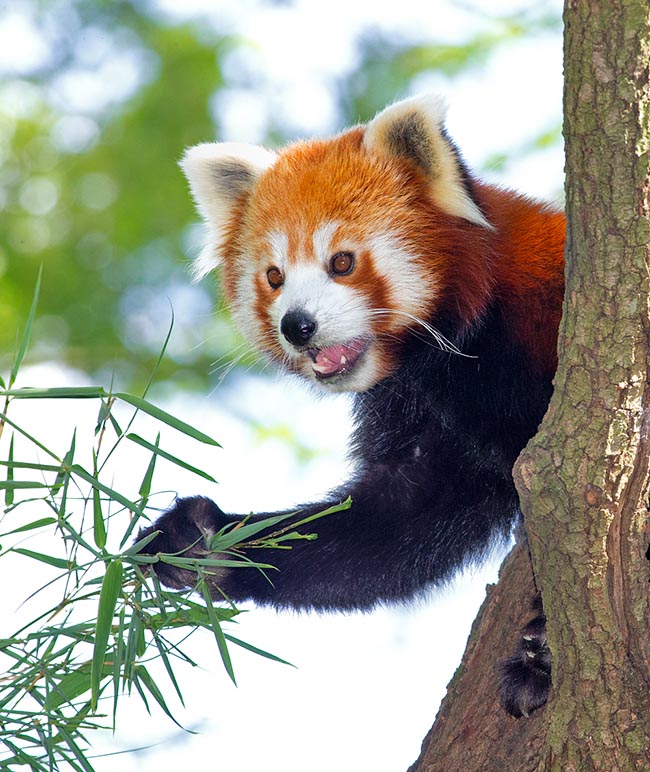
The wrist of the Ailurus fulgens has a well developed sesamoid bone to allowed for similar functions as the primates’ thumb, to grasp, hold on and manipulate branches and bamboo stems as well as other food it feeds on © G. Mazza
The mask of the muzzle of the lesser panda, combined with the tail which has and annulate colouring, with alternated rings reddish-brownish, paler and darker, accentuate the resemblance (actually coarse and superficial to an even minimally experienced eye) between this species and the Raccoon (Procyon lotor). The facial mask of the lesser panda is quite variable in intensity of colouration (more or less dark and drawn) and in extension and presence of white so much to allow, at times, the identification of the single individuals from far away. The thick hair covering the palms of the paws, characteristics common also to the Giant panda (Ailuropoda melanoleuca) and to the Polar bear (Ursus maritimus), forms an adaptation of the species to its own habitat, formed, also, by humid and slippery branches, icy and snowy ground, rocky crevices and inclined slopes.
The tympanic bulla is extremely reduced; this suggests that, in species mainly vegetarian, the auditory function of the bulla has lost its function of refining the hearing of this carnivore in name but not in fact. This because a special adaptation to hunting, and therefore a greater sensitivity for some frequencies, is not any more strictly necessary. As we know, the natural selection tends to eliminate the organs or the systems fallen into disuse. The person who takes care of this species in captivity realizes immediately that the lesser panda does not have an exceptional hearing; in fact, we can get very close to these animals, if we are not in its visual field, until they jump in fright before we reach them. The lesser pandas have teeth where are evident the masticatory characteristics: even if the incisors and the canines are “classic carnivorous”, the molars are big and equipped with numerous cusps, the premolars have undergone an evident process of “molarization”. Furthermore, the jaw has evolved to effect movements with lateral action suitable for a better chewing and shedding of the vegetal material. These anatomical modifications allow the lesser panda to chew very well the leaves of bamboo for digesting them, thus compensating the absence of the intestinal microbial flora (which should have the function of breaking up the vegetal cellular walls) typical of the classical herbivorous species. The lesser panda tends, seen the hypocaloric foods it eats, to save energy spending long time resting.
Ethology-Reproductive Biology
The knowledge about the life habits of this animal when wild are limited. It appears, in fact, that it is extremely difficult to observe it in its inaccessible habitat. It has territorial habits. During the day, the lesser panda alternates, repeatedly, resting pauses to activity periods (a bit like a house cat; Felis silvestris catus). Even if they are more and mainly active at dawn and at dusk (crepuscular animal).
A lot of the activity carried on by this species is dedicated to the research and intake of food (about 8 hours) which is substantially mainly of vegetal origin. The lesser panda, though belonging to the order of the carnivores, as we have seen during the evolution it has become mainly vegetarian. It mostly nourishes of bamboos (leaves) which is very fibrous and, to a lesser extent, of other plants, roots, lichens, berries, seeds, acorns and fruits.
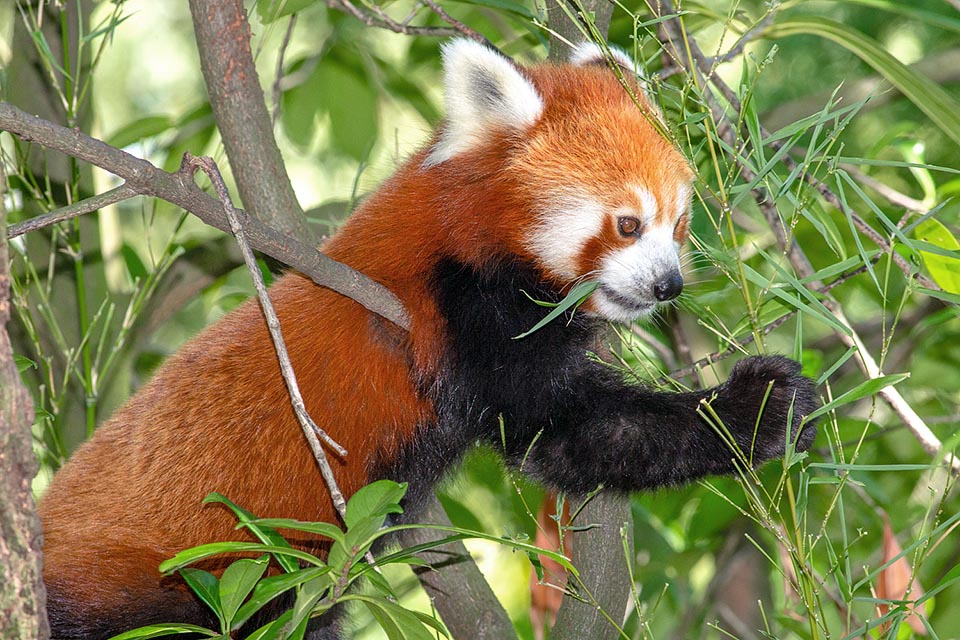
He picks leaves carefully and chews them a long time. With incisors and canines from a carnivore, the molars are large and cuspidate to mince vegetation. Even premolars are adapted and the jaw increases effectiveness with lateral movements. However, the diet is not strictly vegetarian because it eat also insects, rich eggs and birds © Giuseppe Mazza
Though nourishing of much bamboo, like the giant panda, the lesser one tends to eat mainly the lower part, well vegetated, of the plant whilst the giant panda prefers to eat the buds and the more juicy apical parts. The lesser pandas, seen the reduced size and the agility, frequent the least accessible zones and greater altitudes than the giant panda. The lesser panda is called “leaves eater” because of its choice food it carefully selects the leaves to eat discarding those partially or totally dead. Sometimes, it catches small preys such as little birds, small mammals, insects, larvae or other, present on the ground or on the trees. It can also feed of eggs and of carcasses of found dead animals.
From the study of the captive lesser pandas, they have deduced that, in principle, the sensory organs, the anatomy, the frame and the behaviour are perfectly suitable for seizing small animal preys. As a matter of fact, notwithstanding the fact that the natural selection has led this small carnivore to eat mainly the bamboo, easily and abundantly available in its own home range, it is capable to seize upon the sporadic opportunities of finding aliments of animal origin. In this regard, it has happened that lesser pandas living in zoo and hosted together with Reeves’s muntjac (Muntiacus reevesi), in zoological units where animals of different macro-areas are kept in mixed exhibition, they have eaten the newborns of this species. The young of this cervid, during their first days of life, keep motionless and crouch among the grass trying to hide from the predators thanks to the camouflaging look which is, however, by-passed by the fine sense of smell of the lesser panda. I myself have been witness of a predation of a young Common blackbird (Turdus merula), done by a specimen of lesser panda; after a rather slow approach, the predator has done a short run and a productive leap which has enabled it to seize the young bird that has been, immediately, devoured.
They are plantigrade animals and show excellent arboreal qualities; thanks to the sharp claws and to the hairy soles of the feet they can climb the trees with great agility and shin up them, and then get down, head down, from the trunk.
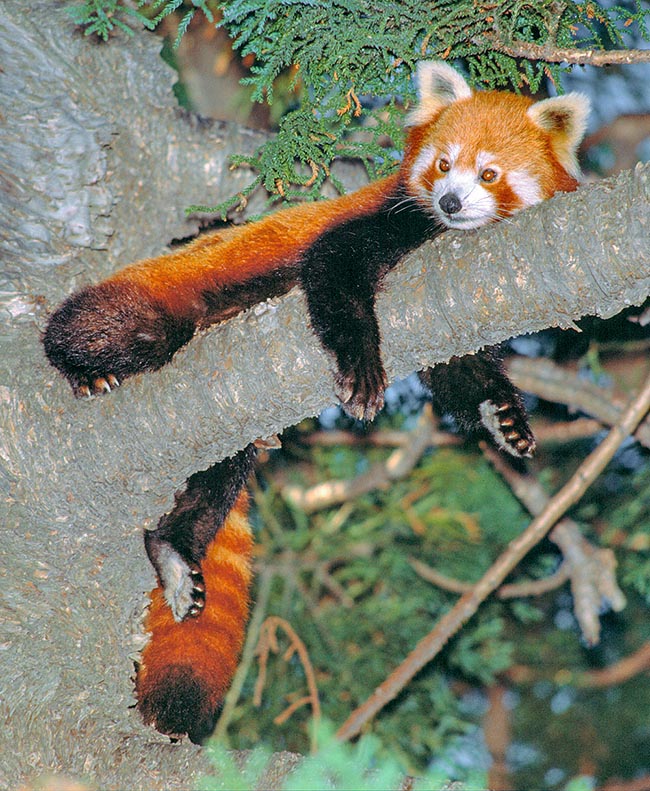
Loves temperatures below 25 °C. When hot, it rests in the shade, half dangling and half astride on a branch © Giuseppe Mazza
When it goes down in this way, the lesser panda rotates the ankle outwards clinging tightly to the bark. In so doing, it gets down rapidly and has a direct vision to the ground for a possible escape or change of direction. When on the ground, it is not rare to see it galloping with its back arched and the tail partially raised flaunting a gait nice and funny at the same time. If it feels menaced and wants to escape it can perform metre long jumps and more. The preferred resting position is a sort of odd balance, half hanging and half straddling, on a branch. However it stays willingly coiled upon a side with the tail arranged like a pillow or used as shelter for the muzzle and the head. Another of its habits is that of cleaning itself by washing as the felines do; at first it licks carefully the inner part of a fore paw and then with this cleans up the muzzle and the ears. For drinking or eating semi-liquid foods it often dips a fore paw and then licks it. When wild, the lesser panda carries on a solitary life; when captive usually lives, without any problem, in par or in small groups of the same sex. The reproductive pairs, in captivity, tendentially reproduce all the years tolerating the presence of the progeny for about one year (until the following delivery).
The communication among conspecifics includes a vast range of vocalizations among which: acute and strong screeches, squeaks, whistles, twitters and sounds similar to muffled grunts. A typical sound resembling the cry of child, “wah” is a strong contact call and is used mainly by the mothers for calling their own babies. When upset, the lesser panda utilizes the ears and the head for signalling its own disappointment (flattened ears, lowered head). If this is not enough, it rises on the hind limbs, snorts, hisses, blows and growls trying to hit the opponent with the fore legs raised and with which it does neat rotating movements. By doing so, with its sharp claws, it is capable to produce even serious wounds. Especially the males are fighting among themselves in this way, carrying out a sort of “boxing match”.
The legs are endowed with extremely wide possibility of rotation so much that it is practically impossible to immobilize one of these animals by grabbing them by the scruff; with the fore limbs it reaches, without any problem, the zones over its own head and the adjacent ones. The lesser pandas indicate their presence by marking the territory with the anal glands. The animal lays the hind legs on a stone or on a branch and then rubs the anal region against a protuberance for impregnating it with the glandular secretion. Besides the anal secretion, in the markings, it uses the sprinkling of reference points with its urine.
The time for mating stands between January and February. The females of lesser panda, after a gestation of about 130 (112-158) days, deliver, as an average, two babies (1-4) usually in a cavity of a tree or of other genus lined with twigs, leaves and grasses. The newborns come to life already covered by hair but with a paler colouration and less contrasted than the adults. The head is white-yellowish-greyish, the back has a faded rust colour, the limbs and the abdomen appear already darker. The eyes and the ears, at the birth, are closed and the soles of the feet are glabrous. The newborns weigh about 80-130 g and are 10-15 cm long, of which ¼ is due to the tail; in the whole they vaguely resemble some newly born Siamese kitten. When 13-18 days old, they open their eyes and their weight has doubled.
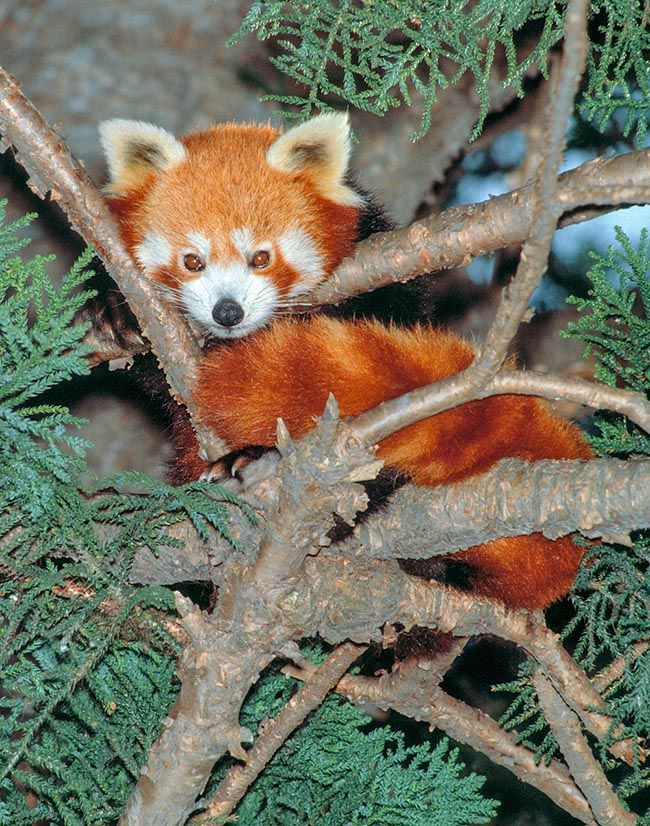
The thick tail serves for balance between branches but also as a soft cushion and a blanket for a peaceful sleep © Giuseppe Mazza
When one month old, the typical characters of the muzzle appear fully developed, the canines and the milk molars appear followed after two weeks also by the milk incisors. The female, since the first days of life, must leave the babies alone in order to assume enough nourishment, fundamental for the production of milk. This species, for getting the right energetic input, must eat a lot of bamboo which, notoriously, is not much energetic. Although the anatomical adaptations for the consumption of the bamboo, the intestine of the lesser panda is short, as a carnivore. This renders the digestion of the aliments of vegetal origin not very efficient. For this reason, the period when the babies are newborns is very delicate; in fact, while the mother is busy eating the sufficient quantity of food the babies, left alone for long periods, may be easily located and predated. Even in captivity, in spite of the protections offered by the fences hosting them, disappearances of newborns have occurred, probably predated by birds of prey or by enterprising wild mustelids.
In order to counteract the vulnerability of the progeny, the mothers often move the babies taking them to new dens (as a matter of fact the mothers already before delivering usually prepare more than one den). This task is accomplished by the mother taking the baby by the scruff and raises and moves it holding the same with the mouth; this behaviour is maintained also in captivity. The young, furthermore, if they perceive the presence of a close intruder, puff and grunt insistently doing funny winces trying to discourage possible foes. When about three months old, the young get out from the nest-den and begin to follow the mother (they are nursed for 3-4 months) with whom they will stay 8, or at most, 12 months. The females deliver once a year; the juveniles will be able to reproduce when two years old (in captivity they are already sexually mature when 18-20 months old). The male does not participate in the breeding of the babies. This species does not live long, and, also in captivity, reaches a maximum age of 10-13 years (in very rare cases until 15 years).
In the wild, the lesser panda can be predated by the snow leopard (Uncia uncia) and by the clouded leopard (Neofelis nebulosa). Its puppies can be, on the contrary, more predated by diurnal and nocturnal raptors. The zoos host mainly the western form which has a more reduced size and a less intense rusty colour. In fact, the oriental form is more delicate, especially regarding the acclimatization outside its own habitat. During the last decades, after a difficult beginning, the lesser panda has reproduced and diffused, globally, in many zoological gardens.
In captivity it is mainly nourished with golden bamboo (Phyllostachys aurea) or similar species, apples, feeds and specific integrators and with a small weekly quantity of food of animal origin. In these structures, every year, some hundreds of babies come to life overall. In captivity, a health issue, sometimes found in the puppies, is the dermatophytosis (Microsporum gypseum). This pathology causes serious ulcerative lesions which are fatal for the puppies. Luckily, a specific treatment with antifungal systemic medicines (Itraconazole) proves resolutive. In the wild, this species is endangered by poaching; in Nepal they use the fur for making head coverings and carpets, whilst in China they use the tail as down and the fur for making brushes. The greatest threat comes from the destruction and the fragmentation of the habitat with relevant increase of the consanguinity and loss of the genetic variability (animals confined only in small still intact areas). For these reasons, although the lesser panda is now globally protected, its population is in constant decline and it seems that in the wild there are less than 10.000 living specimens.
Synonyms
Ailurus ochraceus Hodgson, 1847.
